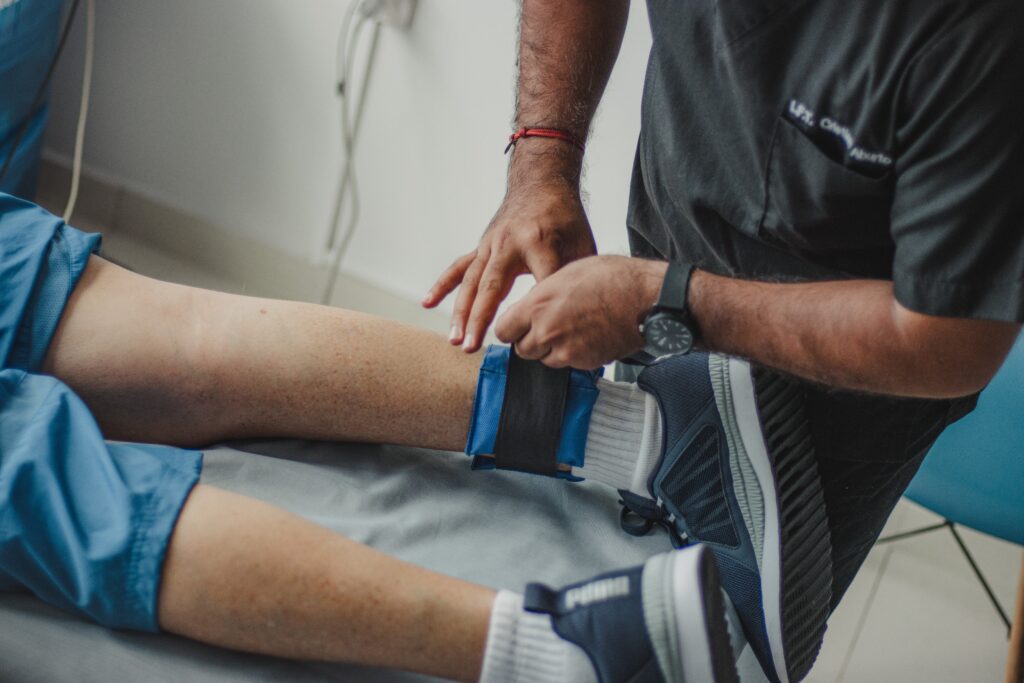All About How Physical Therapy Can Help Foot And Ankle Pain

An Overview Of Foot And Ankle Pain

How Physical Therapy Helps Different Foot And Ankle Pain Diagnoses

How Physical Therapy Helps After Foot And Ankle Procedures

What To Do When You Have Foot Or Ankle Pain With Activity

Interventions That May Help Foot Or Ankle Pain & How They Work
Manual Therapies

FAQ On Foot And Ankle Pain
What causes ankle pain without injury?
Ankle pain without injury can be caused by various factors, often related to underlying health conditions or natural wear and tear. Arthritis is a common cause, with types like osteoarthritis, rheumatoid arthritis, and gout leading to inflammation and pain in the ankle joint. Other conditions like nerve damage or compression (such as tarsal tunnel syndrome), infection, or blood vessel blockage can also result in ankle pain. Additionally, overuse from activities like running or walking on uneven surfaces can lead to ankle pain even without a specific injury. Conditions like flat feet or wearing inappropriate footwear can put extra stress on the ankle, leading to pain. It’s important to consult a healthcare professional for a proper diagnosis if you’re experiencing persistent ankle pain without an obvious injury.
What is the most common cause of ankle pain?
The most common cause of ankle pain is often related to injuries, particularly sprains. An ankle sprain occurs when the ligaments that support the ankle stretch beyond their limits and tear. This can happen during physical activities, by tripping or falling, or when walking or running on uneven surfaces. The severity can vary from a minor injury, which may get better with rest and home treatments, to more serious sprains that need medical attention. While sprains are quite common, ankle pain can also be caused by other conditions such as arthritis, gout, nerve compression or damage, infections, or certain types of footwear. It’s important to seek medical advice if ankle pain is persistent or severe.
What causes ankle pain without injury?
Ankle pain without injury can be caused by various factors, often related to underlying health conditions or natural wear and tear. Arthritis is a common cause, with types like osteoarthritis, rheumatoid arthritis, and gout leading to inflammation and pain in the ankle joint. Other conditions like nerve damage or compression (such as tarsal tunnel syndrome), infection, or blood vessel blockage can also result in ankle pain. Additionally, overuse from activities like running or walking on uneven surfaces can lead to ankle pain even without a specific injury. Conditions like flat feet or wearing inappropriate footwear can put extra stress on the ankle, leading to pain. It’s important to consult a healthcare professional for a proper diagnosis if you’re experiencing persistent ankle pain without an obvious injury.
How do I know if my ankle pain is serious?
Ankle pain can range from mild to severe, and it’s important to recognize when it may be indicative of a more serious condition. If your ankle pain is accompanied by an inability to bear weight on the foot, significant swelling, deformity, or if the pain doesn’t improve with rest and over-the-counter pain relievers, it could be a sign of a severe sprain or even a fracture. Symptoms such as fever, redness, or warmth could suggest an infection. Additionally, if the pain occurs without an apparent injury or if it persists for several weeks, it might be due to an underlying health condition like arthritis or gout. In these cases, you should seek medical attention promptly for a proper diagnosis and treatment plan.
Why does my ankle hurt even though I didn't sprain it?
Ankle pain without a sprain can be attributed to various factors. It could be due to overuse injuries from repetitive activities, such as running or jumping, which can cause conditions like tendonitis or stress fractures. Arthritis is another common cause, where inflammation of the joint leads to pain and stiffness. Other possibilities include nerve impingements like tarsal tunnel syndrome, infections, or blockages in blood vessels. Conditions that affect your body’s structures, such as flat feet or obesity, can also put extra strain on your ankles, leading to pain. If you’re experiencing persistent ankle pain without a known injury, it’s recommended to consult a healthcare professional for an accurate diagnosis and appropriate treatment.
When should I get ankle pain checked out?
Ankle pain may be a common occurrence, but it’s crucial to know when it requires medical attention. According to Massachusetts General Brigham, if you feel a pop or as if you’ve been kicked in the back of the leg, you should seek medical attention within 24 to 48 hours.
What is a common diagnosis for ankle pain?
One common diagnosis for ankle pain is an ankle sprain, which occurs when the ligaments that support the ankle stretch beyond their limits and tear. This can result from physical activities, tripping or falling, or walking or running on uneven surfaces. Other common diagnoses include arthritis (osteoarthritis, rheumatoid arthritis, or gout), which causes inflammation and pain in the ankle joint, and conditions like tarsal tunnel syndrome or peripheral neuropathy, which involve nerve compression or damage. Overuse injuries, such as Achilles tendonitis or stress fractures, can also cause ankle pain. It’s critical to seek medical advice for an accurate diagnosis if you’re experiencing persistent or severe ankle pain.
Ice Or Heat For Ankle Pain?
For ankle pain, the application of ice or heat largely depends on the stage and nature of the injury. According to healthcare providers and podiatrists, ice is generally recommended for acute injuries during the first 24 to 48 hours to help reduce inflammation and swelling, which are part of the body’s natural response to injury. Ice application can also numb the area, thus mitigating pain. After the initial inflammatory stage, usually when the swelling has subsided, heat can be applied to increase blood flow and promote healing of the damaged tissues. Heat can also help alleviate stiffness and improve comfort before activity. However, it’s important to note that everyone’s healing process is unique, so these guidelines may not apply to all situations. Always consult with a healthcare professional for personalized advice.
What does ankle pain with numbness mean?
Ankle pain with numbness typically means trauma or insult to the nerve. This can be from a brief high-intensity impact or from a long sustained pressure. Regardless acute numbness and ankle pain should not be ignored as numbness or lack of feeling, should not be ignored. Reach out to a medical provider to provide more insight.
